| Highways, Byways, And Bridge Photography |
The Best Of The Mississippi
River Bridge Photographs
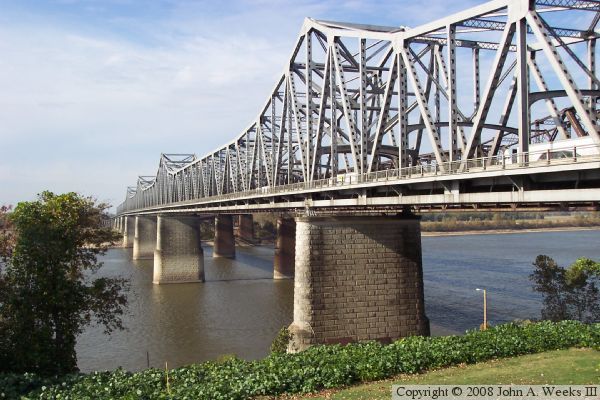
The Memphis-Arkansas Memorial Bridge carries Interstate highway I-55 over
the Mississippi River at Memphis. This mile-long structure with its peaks
and valleys and lattice work of metal beams makes it a textbook example
of a big metal monster bridge. Despite its huge size and its location
on the Memphis riverfront, this bridge is somewhat hidden from view. Two
very large railroad bridges shield the I-55 bridge from the downtown and
riverfront park view, and there are few locations to view the bridge from
downriver.
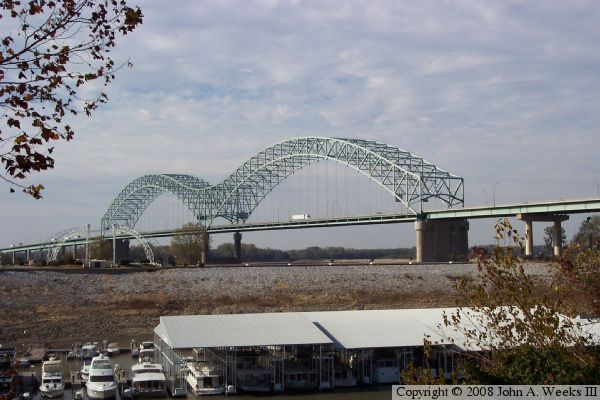
Nothing says "Memphis!" quite the way the giant M shape of the Interstate
highway I-40 Hernando De Soto Bridge leading to downtown Memphis. From a
technology standpoint, this bridge has it all, including a metal truss,
arches, reinforced concrete, steel girders, and suspension cables. Nowhere
else on the muddy Mississippi do you find this mix of construction
methodologies.

This is a very dramatic view of the river bridge near the sleepy little
river town of Chester, Illinois, taken in the early evening just as the
sun has set behind the river bluffs.
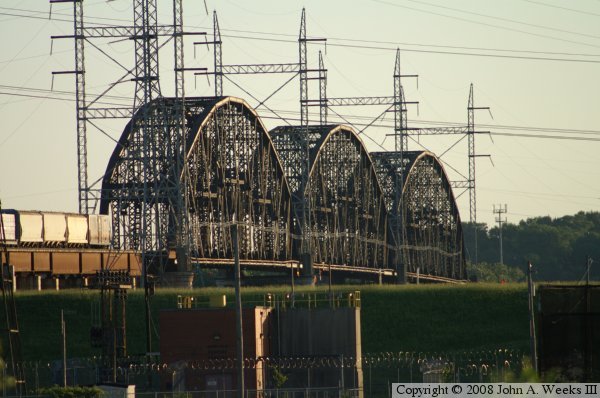
The massive Merchants Bridge near Saint Louis has two parallel railroad tracks
allowing two trains to cross the river at the same time. The bridge was
originally built in 1890 to break the TRRA river crossing monopoly in the
Saint Louis area, but its owners ran into financial problems soon after the
bridge opened, and the bridge ended up falling into the hands of the TRRA.
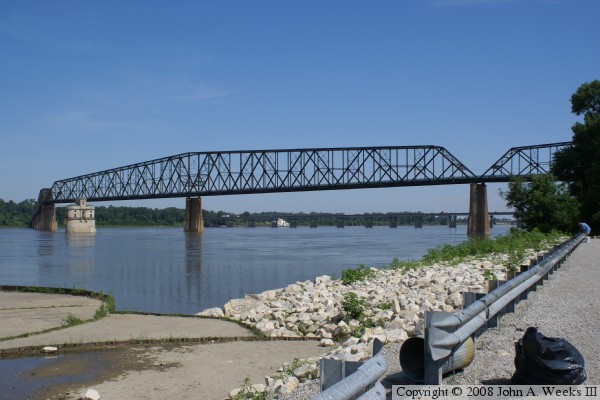
The Old Chain Of Rocks Bridge just north of Saint Louis was once the river
crossing for the famous Route 66. The key feature of this bridge is the
bend in the bridge at mid-channel. This old bridge sat abandoned for
many years, until it was brought back to life as a pedestrian and bicycle
bridge.
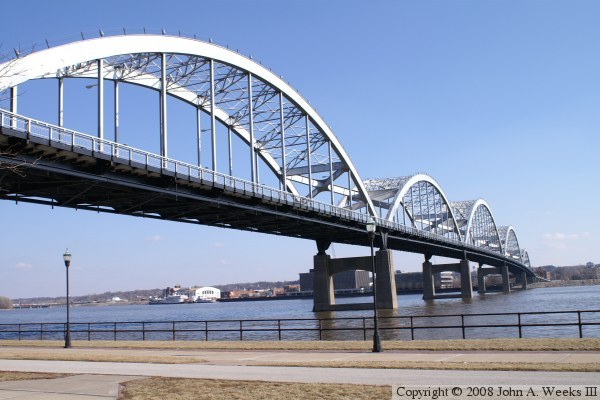
The Centennial Bridge is a signature span for the Quad Cities area. The
five humps of its massive arches contribute to a bridge profile that is
perhaps the most graceful looking of all the bridges that span the
mighty river.
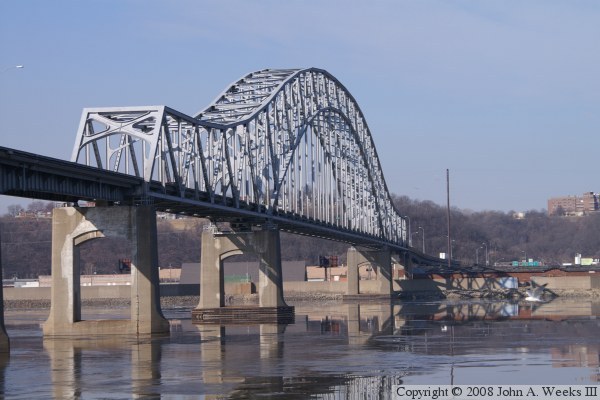
The historic Julien Dubuque Bridge spans the Mississippi River at Dubuque,
Iowa. The icy water and the shadows cast by the low morning sun add drama
to an already very interesting bridge. The bridge itself carries a traffic
load that is well beyond its design capacity. As a result, the states of
Iowa and Illinois are in discussions to develop a plan to solve the traffic
problem. Highway officials are considering adding a twin span or building
an additional bridge a mile or two downstream.
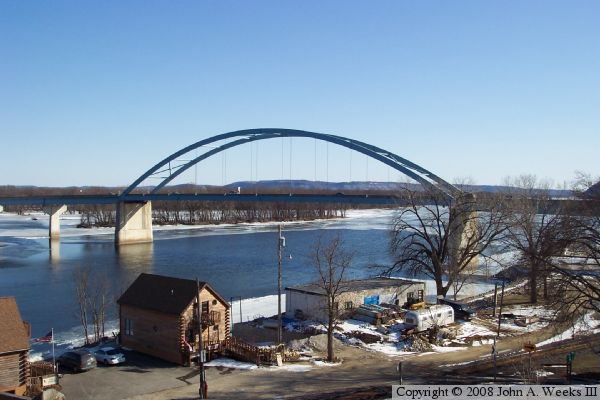
The US-18 Marquette-Joliet Bridge is an early example of a tied-arch bridge,
a design that has been repeated several times on the Mississippi River,
and rivers that feed the Mississippi such as the Missouri River and the
Minnesota River. This bridge was built with defective steel, which required
a major retrofit to the structure shortly after it opened.
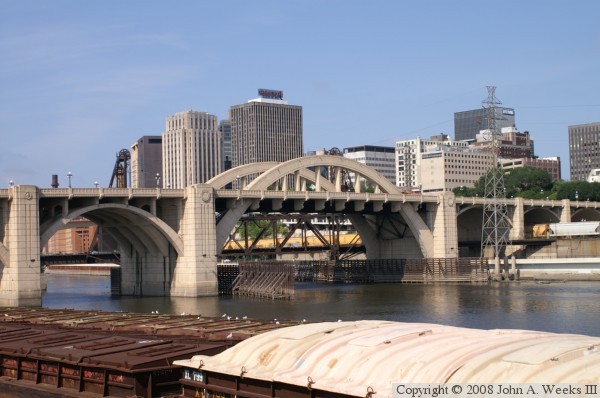
The Robert Street Bridge in Saint Paul is a very rare example of a rainbow
arch, the style of bridge where the traffic deck runs through the middle
of the arch. This 1926 era structure was extensively refurbished in
the late 1980s. Hopefully, that will allow the bridge to serve for
another 60 years before it needs additional major repairs.
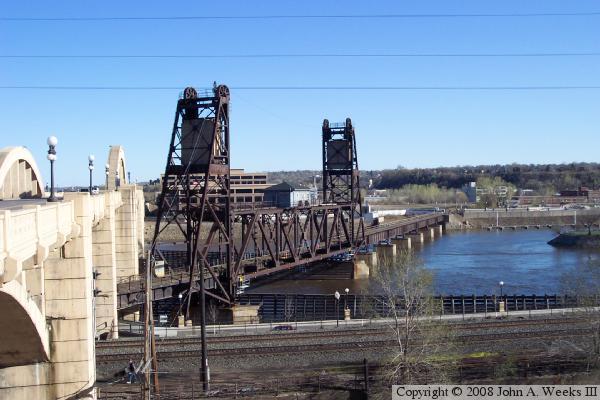
This lift bridge was built in 1913 by the Chicago Great Western
Railroad. The CGW was bought out by the C&NW, which was bought
out by the Union Pacific. The bridge is threaded through the Robert
Street Bridge. The north end of the bridge was raised 16 feet to
bring it up to the level of the Saint Paul Union Depot tracks when the
depot was built in 1925. There are several lift bridges still in
operation on the Mississippi River. Some of the lift bridges were
converted from swing spans, but this bridge started its life as a
lift span.

The Intercity Bridge between Minneapolis and Saint Paul is a great example
of the giant concrete arch bridges that were built in the Twin Cities
area in the first half of the 20th century. It crosses an especially
wide and deep part of the Mississippi River which is backed up behind
Lock & Dam #1. Locals call this the Ford Bridge or Ford Parkway
Bridge due to its proximity to the Ford Motor Company assembly plant.
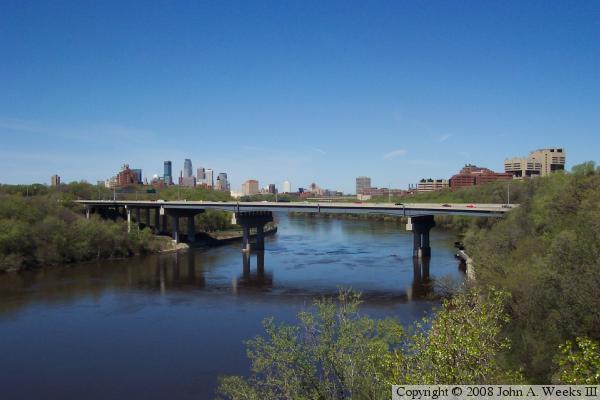
The Interstate highway I-94 Dartmouth Bridge is the busiest bridge over
the Mississippi River carrying over 160,000 vehicles per day. The bridge
was forced into double duty after the collapse of the I-35W bridge in
2007 and 2008 as the river crossing for the I-35W detour. The bridge sits
in a very photogenic location with the downtown Minneapolis skyline to
the left and the University of Minnesota building complex to the right.

The new I-35W Saint Anthony Falls Bridge over the Mississippi River in
downtown Minneapolis is nothing short of stunning when lit up at night. The
computer controller on the innovative lighting system can produce any color in
the spectrum, but the bridge is normally bathed in a light blue glow that makes
the structure look like something straight out of a science fiction movie.
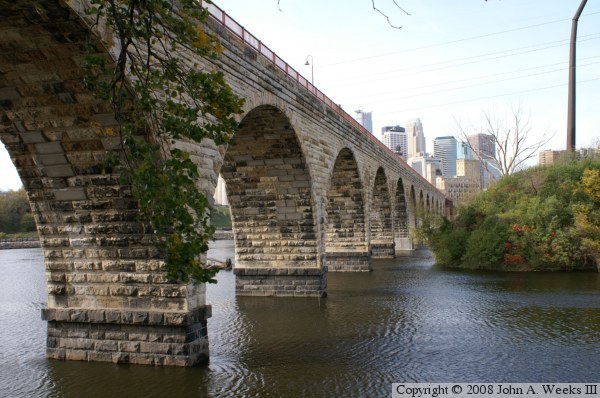
Built by railroad tycoon James J. Hill, the Stone Arch Bridge remains
the centerpiece of the Saint Anthony Falls area near downtown Minneapolis.
The bridge carried passenger trains into the Union Depot for nearly 100
years before passenger rail left the two Twin Cities downtowns. After
sitting unused for over a decade, the bridge was refurbished and reopened
as a pedestrian and bicycle path, one with absolutely spectacular views
of the falls area and the historic milling district.

The Third Avenue Bridge crosses the Mississippi River on the upstream side
of Saint Anthony Falls in downtown Minneapolis. It was taken during the
golden hour just before sunset, with the bridge bathed in yellowish sunlight
while the buildings in the skyline are in the shade. This photo won the
2012 Othmar H. Ammann Award for best photo.
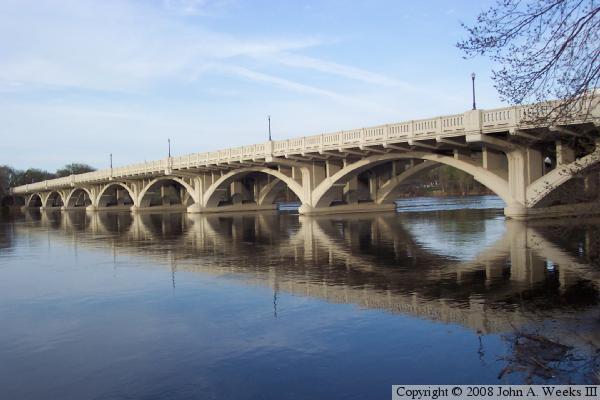
If forced to choose just one favorite bridge over the Mississippi River,
the Ferry Street Bridge in Anoka would be my choice. This 1,000 foot long
concrete arch bridge has style and grace from its art deco era roots that
is unmatched by any other structure over the great river. It is frightening
to recall that this bridge nearly did not survive. It was in such bad
shape that it was closed to traffic for several years while highway officials
debated what to do with this structure. Thankfully, they decided to restore
this bridge, resulting in a bridge that is wider, safer, and stronger than
when it was originally built.

The Old Sauk Rapids Bridge is an example of the deck truss style of bridge
that has a lattice of metal beams under the traffic deck rather than above
the traffic deck. This style of bridge looks routine from the traffic
level, but becomes very interesting when seen from the side or under the
bridge. All three examples of the deck truss bridge that once spanned the
mighty Mississippi were removed in 2007 and 2008, in part due to the bad
reputation assigned to these bridges following the I-35W bridge disaster,
including this bridge.

This prestressed concrete girder bridge is a typical modern design for a
bridge over a small or medium-sized river in Minnesota. This design is
used across the state, including nearly all of the newer highway bridges
over the Mississippi River in the headwaters region. This example crosses
the river at Palisade, having recently replaced an old truss bridge. While
losing yet another truss bridge is hard to take, this bridge will easily
last a century or more.
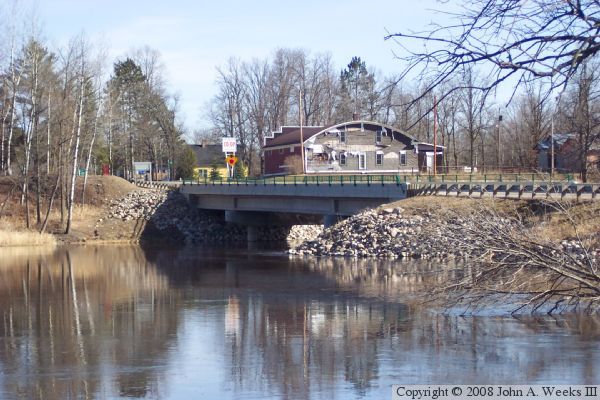
The Jacobson Bridge is a true slice of northern Minnesota. We have the
sleepy country village, the local fishing hole, the run down bar, the
resort in the background, and cabins on either side of the highway. It
sure beats the hustle and bustle of the big city 150 miles to the south.
You betcha it does.
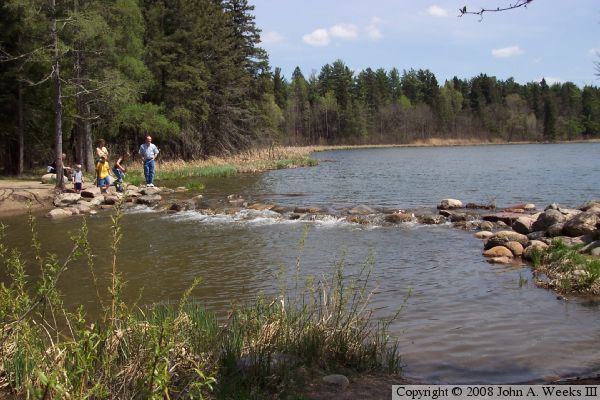
This is where it all begins for the Mississippi River 2,552 river miles
north of the Gulf of Mexico at Lake Itasca in Minnesota. This 44-foot wide
dam is capped with stones forming a walking path across the river. Crossing
the river at this location is a rite of passage for all Minnesota children,
something that everyone should have the chance to do at least once in their
lifetime.
|

